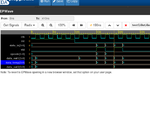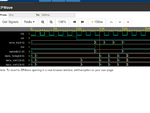hcu
Advanced Member level 4
Hi all,

1.why data_out2 result is not same as data_out1.?
2. how clock (looks) samples data from a io port and from a register ?
Code:
// Code your design here
module data_sampling_doubt1 (
input clk,
input rst,
input [3:0] data_in,
input vld,
input [1:0] opcode,
output reg [3:0] data_out1,
output reg [3:0] data_out2
);
reg [3:0] data_temp;
always@(posedge clk)
begin
if(rst)
data_out1 <= 0;
else if(vld)
case(opcode)
2'b11: data_out1 <= data_in;
default: data_out1 <= 'hF;
endcase
else
data_out1 <= 'hE;
end
// pipelining the input port data into a data_temp register//
always@(posedge clk) begin
if(rst)
data_temp <= 0;
else
data_temp <= data_in;
end
always@(posedge clk)
begin
if(rst)
data_out2 <= 0;
else if(vld)
case(opcode)
2'b11: data_out2 <= data_temp;
default: data_out2 <= 'hF;
endcase
else
data_out1 <= 'hE;
end
endmodule
Code:
// Code your testbench here
// or browse Examples
module test1();
reg clk;
reg rst;
reg [3:0] data_in;
reg vld;
reg [1:0] opcode;
wire [3:0] data_out1;
wire [3:0] data_out2;
data_sampling_doubt1 dut(
clk,
rst,
data_in,
vld,
opcode,
data_out1,
data_out2
);
initial begin
$dumpfile("dump1.vcd");
$dumpvars;
rst =1;
data_in = 0;
vld = 0;
opcode = 0;
#100 rst =0;
#50;
data_in = 'hb;
vld = 1;
opcode = 'b11;
#20;
vld = 0;
opcode = 0;
data_in = 'hc;
#20;
vld = 1;
opcode = 0;
data_in = 'hd;
#20;
vld = 0;
opcode = 0;
data_in = 'h0;
#200;
$finish;
end
initial
clk =0;
always #10 clk = ~ clk;
endmodule
1.why data_out2 result is not same as data_out1.?
2. how clock (looks) samples data from a io port and from a register ?
